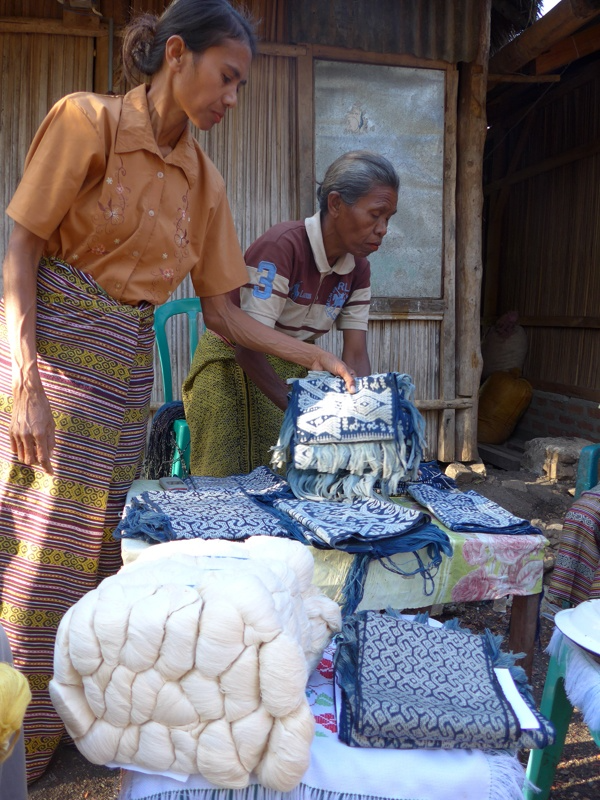Next Steps for Weavers in Timor
This was my second trip to Timor this year and there will be one more trip the end of November. Compared to other islands, West Timor has the most number of weaving groups Threads of Life works with.

This was my second trip to Timor this year and there will be one more trip the end of November. Compared to other islands, West Timor has the most number of weaving groups Threads of Life works with.

The landscape is already dry and there are still three months to go before the rains come
This trip I found myself aware of how fragile the landscape is. In May, the island was still green as the rains had just ended. Corn harvests were being stored in the lofts of the lopo rice barns of people’s homes. Water was still flowing in streams.
The difference between May and August is huge. Trees are already shedding their leaves and people are walking longer distances to collect water for cooking and drinking. Staying in villages of weavers we work with, I found myself very mindful of how much water it takes to fill a bucket for a bath or to flush a toilet. Like my colleagues Wenten and Yansen, we washed our faces only and waited until we were in a larger city to bathe.

Children walk to carry water for their homes before and after school

Cash from her textile sales has helped this weaver begin to build a new house
The rains will not come until the end of November. I think about how this will impact on people’s lives here: my goodness, another three months to get through. It will be easier for the weaver groups where we are working. We are seeing weavers use cash generated from the sale of textiles to begin building new houses and buy water storage tanks.
As an organisation, we can’t fix the landscape and climate in Timor, but as individuals we see that we can make a difference by continuing to help weavers produce high quality natural dyed textiles that sell for much more than synthetic dyed cloth. This is why we all keep making these trips. One of our guiding principles has always been that we give people the means to help themselves. In practice this means we rarely give material donations. We offer the means to make a own living. We give assistance in reviving dyes recipes. And we sell weavers raw materials at cost that they cant get locally or seasonally.

Supplying good quality cotton threads to weaver groups

Symplocos provides the aluminium necessary to achieve the red color on cotton from Morinda root bark
These raw materials are usually sold in the form of an advance against future production. In this way, the weavers don’t have to come up with cash in order to keep working. Other than high quality cotton thread, the other major need has been for a good supply of the aluminium source for the red dye process. This is from the dried fallen leaves of Symplocos. Threads of Life has been purchasing Symplocos from its sister organisation, the Bali Foundation (www.plantmordant.org), for the past four years now and selling it on at cost to the weavers.
Supplies of Morinda roots, which are the source of the red dye colour, are also limited in many regions such as Kalimantan where the forests have been cleared. Currently Threads of Life buys dried Morinda roots from Sumba and sells them to weavers groups in Kalimantan. Elsewhere, we encouraged many of the communities that we work with to start growing Morinda trees five to seven years ago, and these are now starting to be harvested. From this, some inter-group trade can be generated.

Threads dyed with Morinda and mordanted with Symplocos leaf powder

A Tais Keut Bati Rarote textile from Timor dyed with Morinda red
If we find weavers making a culturally important textile, but using synthetic dyes, we will sometimes start by supplying them with natural-dyed threads, dyed by the Bebali Foundation. We let the weavers know they will make more money if they can do the entire process and, when they ask to be taught how to use Morinda, the Bebali Foundation steps in to teach them. But where will they get their Morinda supplies? Again the Bebali Foundation is working to supply this resource as an intermediary measure while communities begin to cultivate their own sources of Morinda.
During these long dry seasons, indigo plants got to seed and die back. For most weavers, who work from fresh leaves, this means they can only make blue for a few months a year. Their production capacity and therefore their income is limited by the supply of this critical dye plant. Threads of Life and the Bebali Foundation are now working on this problem in two ways. From Javanese indigo growers, we have started to buy indigo paste that Threads of Life will sell on to dyers in Timor who cannot find a dry season source of indigo. An September we will do our first test with a competent weaver and dyer in Timor. And in Timor this coming monsoon season we are starting hectare-scale trial of indigo (Indigofera tinctoria) cultivation from which farmers can make an indigo paste that can be sold to local weavers or find a wider market. With these strategies we want to see if we can bridge these dry season problems with a new source of indigo dye for weavers so that income can grow when crops cannot!

Indigo dyed ikat threads showing the Atoni or ancestor motif

